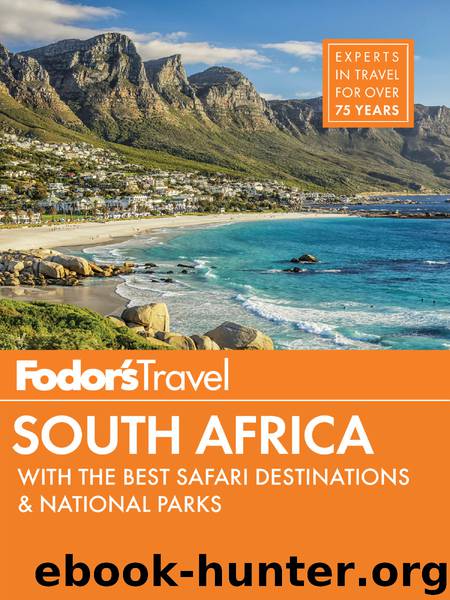Fodor's South Africa by Fodor's Travel Guides

Author:Fodor's Travel Guides
Language: eng
Format: epub
Publisher: Fodor's Travel Publications
Published: 2015-03-25T04:00:00+00:00
Previous Chapter | Beginning of Chapter | Next Chapter | Table of Contents
Main Table of Contents
The Eastern Cape
Frontier Country and the Sunshine Coast
Amatole
Wild Coast
Previous Chapter | Next Chapter | Table of Contents
Getting Oriented | Planning
Updated by Christopher Clark
The Eastern Cape is South Africa’s most diverse province and has some of its best vacation destinations, yet it is perhaps the most glossed over by overseas visitors. Starting where the Garden Route stops, it includes much of the Great Karoo—a large, semidesert region of ocher plains, purple mountains, dramatic skies, and unusual, hardy vegetation—and abuts KwaZulu-Natal in the northeast and Lesotho’s mountain lands in the north. But a glance at a map will reveal the region’s main attraction: its coastline, still largely undeveloped and running for some 640 km (400 miles) from temperate to subtropical waters.
The climate is mild across the region and throughout the year, with temperatures at the coast ranging between winter lows of 5°C (41°F) and summer highs of 32°C (90°F). It has many of the country’s finest and least crowded beaches, Afro-montane forests (one of South Africa’s eco-regions) and heathlands, an ever-increasing number of fantastic malaria-free game reserves, and some of the most interesting cultural attractions in South Africa.
There are a few areas of note. Frontier Country, formerly known as Settler Country, stretches from the outskirts of Port Elizabeth to Port Alfred in the east, Grahamstown in the northeast, and the Zuurberg Mountains in the north. It was here that the early-19th-century immigrants (colloquially called the 1820 Settlers) tried to set up farms, some successfully, some not. Toward the end of the 20th century, many of the unprofitable farms were bought up and redeveloped as game reserves, thus adding superb game-viewing to the already existing cultural attractions.
Frontier Country also overlaps with the Sunshine Coast, an almost invariably sunny 500 km (310 miles) stretch of coastline (hence the name) running from the pretty and pristine coastal towns and villages around Cape St Francis and St Francis Bay all the way to the city of East London, taking in a range of great family-friendly beaches, eco-trails, lagoons, and forests, and the surfing mecca of Jeffreys Bay along the way.
Another noteworthy region on the Eastern Cape is the Wild Coast. Unfortunately, the Wild Coast lost a lot of its allure during the political uncertainty of the 1980s—more because of the perceived threat of violence than anything else. Hotels went out of business, the overnight huts on the fantastic Wild Coast Hiking Trail fell into disrepair, and the Transkei—the name given to this previously designated Xhosa “homeland” by the former apartheid government—sank further into economic depression. For many years it was only die-hard locals with strong emotional ties and small groups of backpackers who frequented these still-lovely and little-known places. Happily, the area has gone through a significant revival in recent years. Coastal hotels have been renovated one by one, and community projects are continually being put in place to ensure that the tourist dollar goes where it should.
Download
This site does not store any files on its server. We only index and link to content provided by other sites. Please contact the content providers to delete copyright contents if any and email us, we'll remove relevant links or contents immediately.
1610396766 (N) by Jo Ann Jenkins(1298)
Whatever You Do, Don't Run by Peter Allison(1248)
Botswana--Culture Smart! by Michael Main(1239)
In Arabian Nights by Tahir Shah(1203)
The Old Farmer's Almanac 2020 by Old Farmer’s Almanac(1157)
Livingstone by Tim Jeal(1153)
Ubuntu by Ellis Heather;(1138)
The Templars by Michael Haag(1126)
Dead Eye by Mark Greaney(1111)
Africa: Altered States, Ordinary Miracles by Richard Dowden(1080)
Top 10 Israel and Petra by DK Travel(1073)
Morocco Travel Guide by Lonely Planet(1067)
Egypt Travel Guide by Lonely Planet(1057)
The Promise of a Pencil: How an Ordinary Person Can Create Extraordinary Change by Braun Adam(1055)
False Papers by André Aciman(1053)
First Comes Love, then Comes Malaria by Eve Brown-Waite(1042)
Jeff Corwin by Jeff Corwin(1031)
The Masked Rider by Neil Peart(991)
African Nights by Kuki Gallmann(968)
